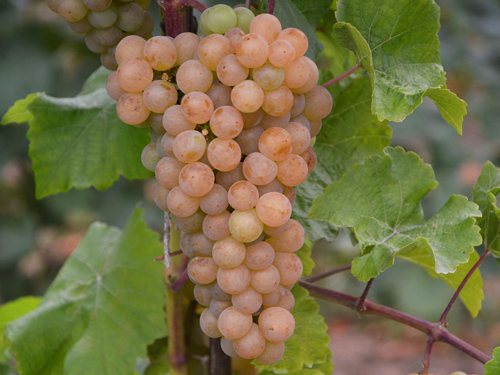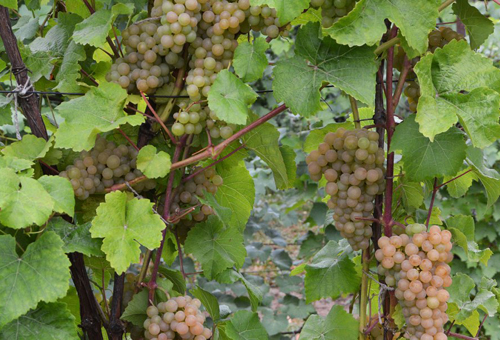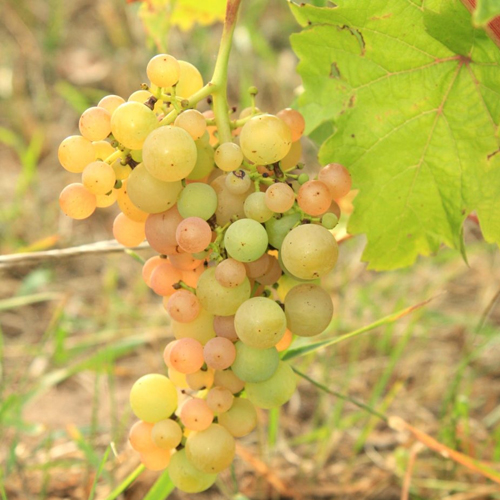Grape variety Platovsky
Platovsky is an excellent result of the work of scientists from the All-Russian Scientific Research Institute of Viticulture and Winemaking named after A. ME AND. Potapenko. A high-quality technical variety was obtained at the end of the last century in Novocherkassk by hybridizing two unpretentious varieties of foreign and domestic breeding - Pearl Zala and Gift of Magarach. As a result, a hybrid form was born, which, without undue modesty, can be called the standard of modern grapes, both in terms of quality and in agrotechnical terms. In addition to the main name, one more was assigned to it - Early Dawn.
The main advantages of the novelty over the varieties of previous generations are: early maturity, excellent fruitfulness of shoots, truly gigantic yield, high resistance to diseases and pests, including phylloxera, as well as very good resistance of the vine to low temperatures. And all this with the remarkable quality of the harvest, which has everything necessary for the production of various types of white wines.

The appearance of Platovsky made a breakthrough in the field of domestic amateur winemaking. Many winegrowers from those regions where until recently it was unthinkable to obtain high-quality raw materials for making homemade wines, only thanks to these grapes they got such an opportunity. But in industrial winemaking, our hero is gradually gaining popularity, where he is already used to prepare environmentally friendly drinks.
It is natural that soon after the appearance of this masterpiece, it passed a full-fledged state variety test, was officially registered in the State Register of Breeding Achievements of the Russian Federation and was recommended for use. The authors of the variety - Ivan Kostrikin, Alexander Maistrenko, Svetlana Krasokhina and Lyudmila Lychova inscribed their names in golden letters in the history of domestic grape selection.
Agrobiological characteristics
The grape bushes are characterized by medium vigor. Young shoots are bright greenish-red, and often burgundy. Leaves are medium-sized, rounded, consist of five lobes with a slight dissection between them. The surface of the sheet is large-bubble, corrugated, dark green; the dorsum is covered with bristly pubescence. The profile of the leaf blade is funnel-shaped or wavy with raised lobes. The veins are red at the base, light green closer to the edges of the leaf. The upper side cuts of medium depth, as a rule, are V-shaped, but there are also lyre-shaped ones with a pointed bottom. The lower notches are almost invisible or absent altogether. The petiole notches are closed, without a lumen. Petioles are long, with noticeable anthocyanin pigmentation. Lateral teeth of medium size, triangular, with a wide base, convex edges and rounded apices. The flowers are bisexual, perfectly pollinated in any weather. The berries of the variety are not peas, and the bunches grow full-bodied, without excessive loosening. This year's growth is ripening well - by 80-85% of its length. After that, the vine takes on a rich brown color. The autumn color of the leaves is yellow.
Ripe bunches of Platovsky reach a mass of 200-220 grams, which is not bad at all for technical grapes. Brushes are cylindrical-conical, of moderate density. The combs are medium, light green. The stems of the berries are short, with not too strong attachment of the berries. Grapes are lined in clusters, rounded, and when densely arranged, somewhat deformed, yellowish-white with a pink tan on the sunny side. The surface is covered with a matt coating of the spring. The size of the berries is average, the weight is about 2 grams. The pulp is slightly firm, but juicy enough. The taste is neutral, harmonious, without bright varietal tones in the aroma and aftertaste. In the total mass of bunches, the proportion of juice is at least 70%.Its sugar content in the technical phase of berry ripeness reaches 20-21 g / 100 ml, titratable acidity is 8-9 g / l. When the crop is fully ripe, the sugar content increases slightly. The skin of the grapes is thin but firm. The seeds are present, 2-3 in number in the berry.

Despite the fact that our hero is considered a technical variety, it can be successfully used in home canning. It will make excellent juices, compotes, and preserves. If you do not pay attention to a not too large bunch, then it will be quite suitable for fresh consumption. Many hobbyists state that they like its taste better than any other variety. However, nevertheless, the main use of the crop is in winemaking, for which juicy, sweet berries are an excellent raw material. Depending on the timing of harvesting grapes, it is used to prepare table or dessert wines. Technologies are being developed for its processing into other types of alcoholic beverages,
A remarkable property of our hero is his early maturity. Only 110-115 days of growing season is enough, counting from the day of budding, for the crop to acquire conditions that meet technological requirements. In the south, harvesting is usually started at the end of the first - beginning of the second decade of August. During this time, plants need about 2200-2300 ° C of the sum of active temperatures. This testifies to the possibility of its cultivation in non-traditional viticultural areas, because with such modest needs, it will have enough heat even in the Moscow region. The increased frost resistance of the vine also contributes to the movement to the north. In Platovsky, this figure reaches −28 ... −29 ° С, which allows in many regions of the shelter zone to abandon this laborious procedure, and in the most frost-dangerous growing places - to simplify the shelter by an order of magnitude, compared to conventional varieties.
Fantastic productivity of grapes is another parameter for which its admirers adore the variety. In the course of state variety testing, on average over the years, a result of 373 centners / ha was demonstrated, and the maximum - 489 centners. Such high rates became possible due to a very high percentage of fruitful shoots (85%), a significant number of clusters on them (1.3 on average), and, most importantly, the ability of plants to “pull out” the highest loads without signs of overload and lengthening of the growing season. set during spring pruning.

A crop that has ripened to its initial conditions can continue to remain on the bushes for up to a month, if, of course, the climatic conditions of the region permit. At the same time, it continues to accumulate sugar and becomes suitable for processing into high-quality dessert drinks. Some winemaking companies use these grapes to produce unique "naturally semi-dry" wines, in the manufacture of which only natural sugar contained in the wort is used. Cracking of berries and the defeat of bunches with rot during full ripening usually does not occur, but wasps, as well as birds, can cause some damage. To prevent this, special means of combating and repelling pests are used, which do not have a chemical effect on the crop.
Agrotechnical features
As a talented person - talented in everything, so technologically brilliant Platovsky - is magnificent in economic terms. Even a beginner in viticulture can be entrusted with the cultivation and care of the variety, and still our hero, with a high degree of probability, will produce a wonderful harvest.
The most responsible procedure is the planting of a vineyard, since mistakes made at this stage will have to be felt for decades.High-yielding grapes require fertile areas with adequate moisture, warmth and sunlight for rapid growth and abundant fruiting. In the south, it can be both plains and slopes of various exposures, except for frankly cold ones, but closer to the northern boundaries of the distribution area, the choice of a planting site will have to be approached with particular care in order to provide the plants with suitable conditions for the ripening of the crop. If there is a risk of SAT deficiency, the bushes are placed in the upper part of the southern slope, and in the backyard and summer cottages - in a "wall" culture, protected from cold winds. Each bush must be provided with at least 4-4.5 square meters of nutritional area.
In traditional viticultural zones, most of which are infected with phylloxera, grape propagation is carried out by seedlings grafted onto phylloxera-resistant rootstocks. The most suitable is Berlandieri x Riparia Kober 5BB, with which the variety has good compatibility. However, due to a certain resistance of Platovsky himself to the pest, on light sandy or sandy loam soils, it is possible to plant root-own seedlings even in areas of continuous soil contamination by root aphids. And even more so, a similar breeding method is suitable for regions free of phylloxera.
If possible, it is recommended to form plants on a high (about 100 cm) trunk according to the principle of a two-armed cordon. In this case, the variety is able to show its most excellent properties in terms of both yield and quality of the fruit. However, if winter temperatures in the region drop below -28 ° C, the idea of a high-stem culture will have to be abandoned, forming bushes according to squat covering patterns. In most cases, a simple earthen shelter will be enough for a frost-resistant vine, and only in the most severe conditions will the variety need a powerful multi-layer insulation.
Pruning fruiting plants will also not be difficult due to the fruitfulness of grape shoots that have developed even from the lower eyes. This allows you to shortly cut the fruit arrows by 3-4 buds, and bring the total load on the bush to 60-80 eyes. With the beginning of the growing season, it will only be necessary to produce a fragment of a few sterile shoots, on which, in principle, the regulation of the load will end.
Well, once again, one cannot fail to mention another remarkable property of Platovsky - complex resistance to the main diseases of the vineyard - mildew, powdery mildew and gray rot. This fact allows cultivating the variety in the absence of contact with pesticides, getting an excellent harvest without any "chemistry".








